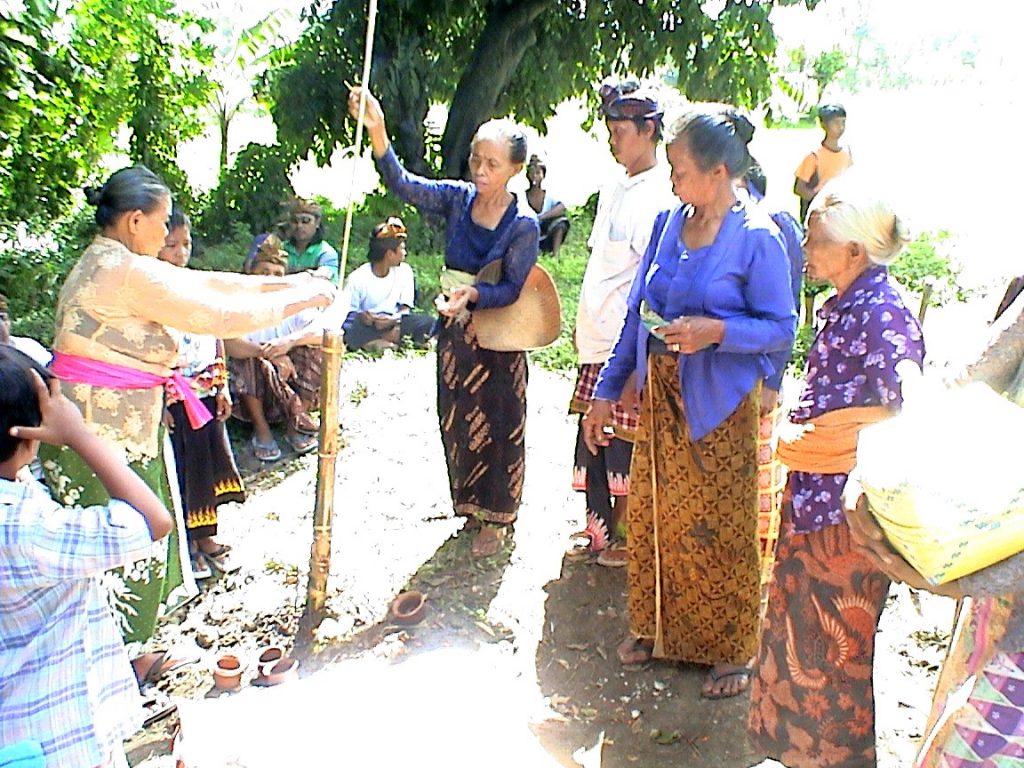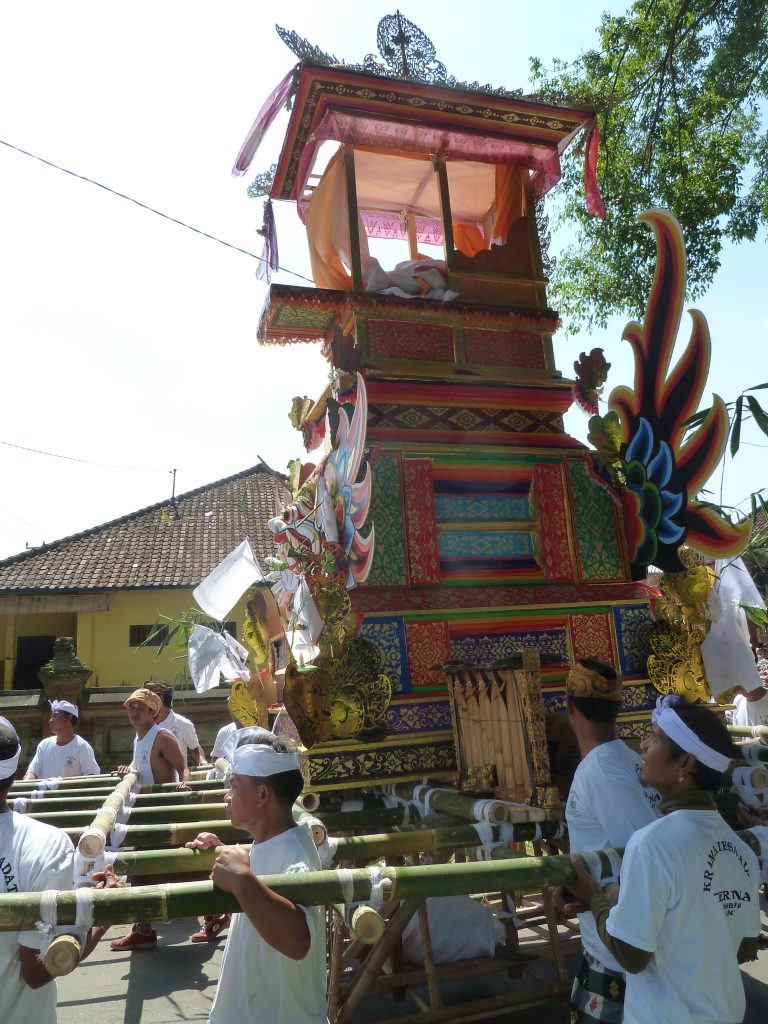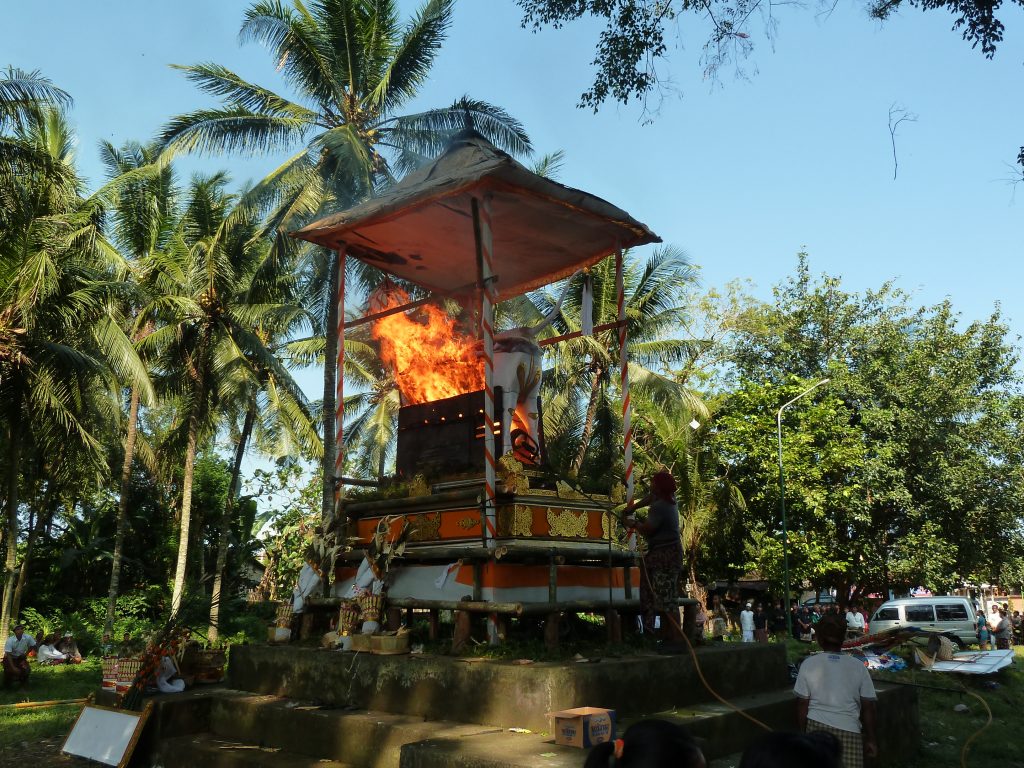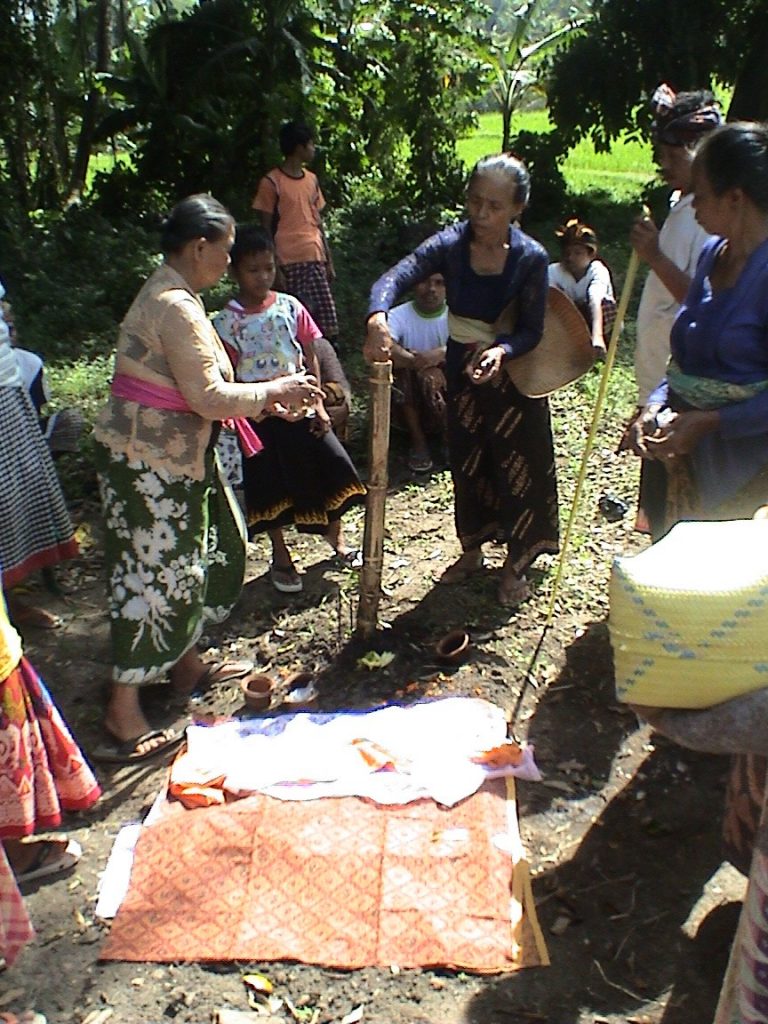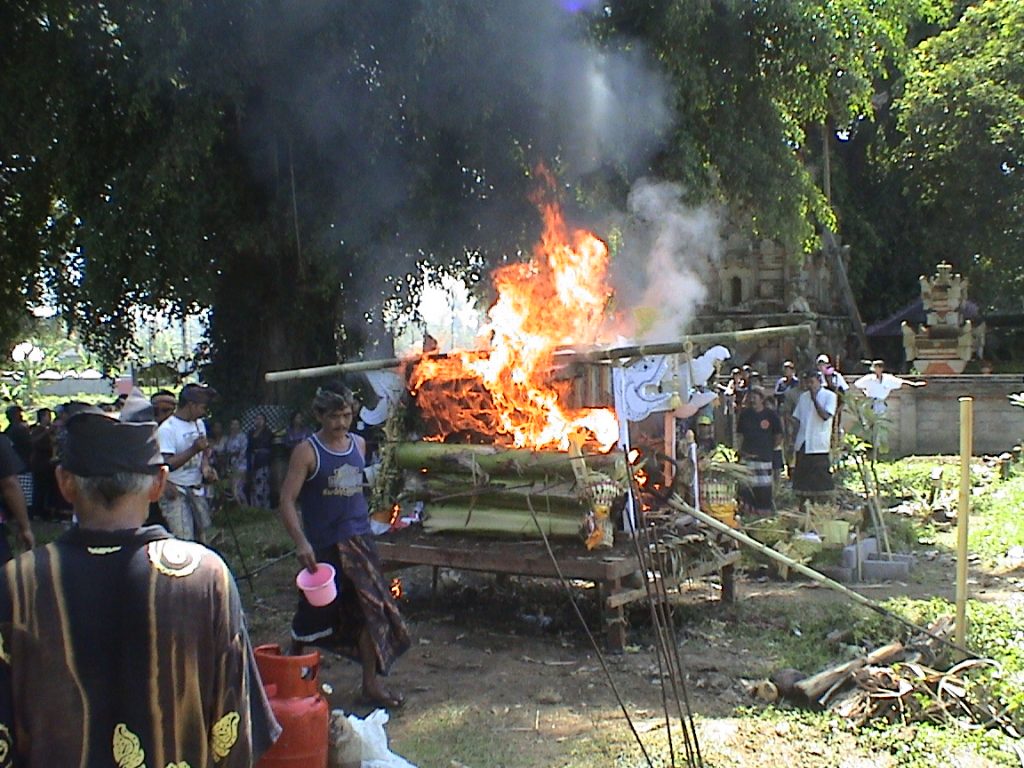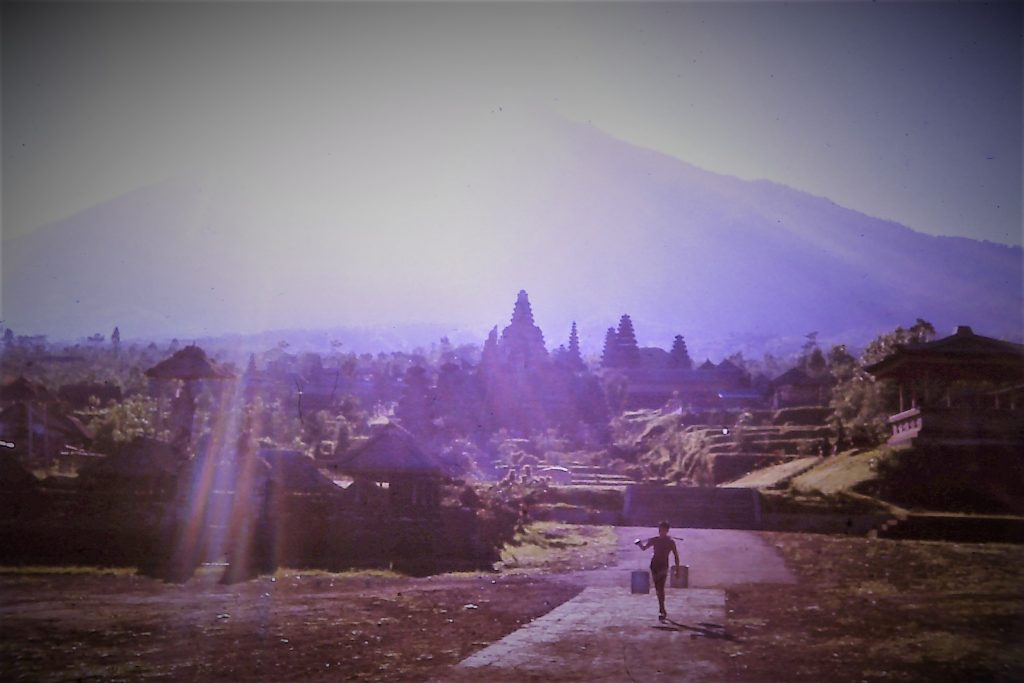Bali is an island located in Indonesia renowned for its beauty, vibrant culture and religious practices (Peacock 102). Hinduism is the most prominent of all the religions in Bali (Peacock 102). Balinese Hinduism can be traced to its origin in mainland India (Peacock 102). However, the Balinese practice their faith in many ways unique from mainline Hinduism with sacred rituals and ceremonies distinct from all other Hindu sects (Howe 57). They have been able to preserve their unique cultural practices and traditions because they are isolated primarily in rural Bali, away from outside influences of Islam and the West (Peacock 102). Some of these distinctive religious practices are related to childhood rituals, as part of the Hindu life cycle (manusa yadnya) (Jenson 21). Additional rituals are observed beginning with the day of birth, centering around the separation and burial of the placenta (Jenson 21). This is followed by rituals at 7 days after birth, at one month, at one month and seven days, and at six months (Jenson 21). Many childhood Hindu rituals function as rites of passage such as the naming ceremony, puberty, birthdays, and tooth-filing (Howe 58). The three rituals given prominence are the three-month ritual, the first birthday, and tooth-filing (Lansing 35 – 37). Since these three rituals mark significant rites of passage in the life of a Balinese Hindu, they will be the focus of this article.
The three-month ritual, known as the nyabutanor tiga bulan ceremony, is practiced to bring the infant into earthly human existence (Barth 39 Williams 254). For the first one hundred and five days of an infant’s life, it is viewed as divine in nature, the incarnate form of one of the father’s ancestors re-born (Lim 1997, np). The infant is bathed twice a day; once in the morning and once in the evening (Jenson 65). Since the baby is considered to be divine, the bath water is deemed sacred (Lim 1997, np). During this period, the child is not allowed to touch the ground, to prevent ritual pollution (Barth 39). Families along with their extended relatives go to great lengths to prevent uncleanliness and ritual pollution, ensuring that the infant is carried everywhere for its first three months of life (Williams 253-254). The ritual contains broader elements beyond solely introducing the child into earthly life. The secondary purpose is transforming the baby’s spirit through taming and purification, while simultaneously ensuring health and strength (Lansing 35). Offerings are made to the Sun god and the five great elements, five spirits of the outer world, represented by earth, air, fire, water and ether witness the offerings and respect given to them through the child (Lansing 35).
The process of performing the three-month ritual is the responsibility of a religious leader, either a Brahmin priest or a ritual specialist, depending on the family’s income (Lansing 35). Wealthy families can afford a Brahmin priest, while others turn to a ritual specialist instead (Lansing 35). The ceremony typically takes place in the family temple and the infant is usually dressed in white and yellow (Williams 254). The priest begins by dedicating an offering to the sun god and the five elemental spirits, also commonly referred to as demons (Lansing 35). Symbolically, the child is composed of its own spirit, as well as the four sibling spirits, whose names change as the child grows into adulthood (Lansing, 35). These four sibling-spirits, guide and determine the infant’s fate as it grows into adulthood (Lansing 34). In the next step of the process, the priest purifies the parents of the infant through prayers and the sprinkling of holy water (Lansing 36). Afterwards, the parents carry their baby clockwise around a jar of holy water three times to signify the life cycle (manusa yadnya) of birth, life, and death (Lansing 36). A representation of the infant is created using various kinds of fruit or vegetables, most commonly either a banana or a coconut (Lansing 36, Lim 1997, np). This effigy is blessed by the priest with holy water and for a time is treated as though it is the actual infant, whether by being placed in the cradle or near the built shrines, or treated as the child by the mother (Lim 1997, np, Lansing 36). This effigy is later taken away and destroyed (Lansing 36, Williams 254). This is done to trick and mislead any malevolent demons, allowing the baby to grow up in peace (Lim 1997, np, Lansing 36, Williams 254). Various forms of jewelry, such as an amulet filled with lucky stones, a piece of the infant’s umbilical cord, or in the past a tooth from a tiger, are blessed in holy water and placed on the infant for protection (Lansing 36, Lim 1997, np). The child is blessed with various kinds of holy water and given its first taste of food, typically rice or rice flour (Williams 254, Lim 1997, np). Finally, the mother walks with her baby across a drawing of the ultimate avatar, a turtle with the symbol for Om on its back and through some holy water, before placing the infant on the ground for the first time (Lim 1997, np, Lansing 36).
Variations may be found in the execution of this ritual. Some sources mention the priest drawing the ultimate avatar with the symbol of Om on its back, while others did not. Additionally, the inclusion of the baby eating a first meal varies from text to text. Aspects that all sources include are the creation of an effigy, the purifying with holy water, and blessed jewelry being placed on the infant. Lastly, there was disagreement on when the child first touches the ground, most sources saying during that it occurs during the nyabutan ceremony, while a few stated it occurred on the first birthday, oton.
The next major ritual in a child’s life is their first birthday known as oton (Howe 59). It is celebrated when the child is six months old or, more precisely, two-hundred and ten days old (Lansing 36). The ritual nyambutan, the three-month ritual, is repeated every six months until the child is six years old (Howe 59). Thereafter, the child is considered an autonomous human being, able to distinguish right from wrong and thus morally accountable for its actions, whereas before the child was criticized little, as it was still considered partially divine (Howe 59). These otons are repeated in order to cleanse the soul from a variety of ritually polluting sources with an offering known as bia kaon (Howe 59).
Though the oton ceremony very closely imitates the nyambutin ritual, there are many novel aspects (Lansing 36). In the child’s first oton, the infant is given its first hair cut and its first “real name” (Lansing 36-37). The child’s real name is given by the priest, who, through divination, chooses a name for the child (Lansing 37). There are numerous ways that a priest may divine the child’s name (Lansing 37). In some cases, this divination is done by writing names on several pieces of a palm leaf, which are then set on fire (Lansing 37). Whichever leaf segment burns the least or takes the longest to burn is the child’s name (Lansing 37). Wealthy families may engage in more elaborate ceremonies (Lansing 37). For instance, a chicken may be introduced into the ritual that will symbolically remove all dirt and grime from the child’s mouth (Lansing 37). Additionally, the jar introduced in the nyambutin ritual may reappear at which time the child may place a fish in the jar in return for a small article of gold jewelry (Lansing 37). Cakes are sometimes given to symbolize the quality of generosity (Lansing 37). It is also traditional in families that can afford it to hold a shadow puppet performance (Lansing 37).
The final primary childhood ritual is tooth-filing (metatah). It is traditionally done when a child, girl or boy, reaches sexual maturity (Lansing 37). The ritual does not have to be completed at the time of puberty, often being postponed until just before marriage (Boon 213). Most families postpone the ritual because it is very costly (Howe 59). Some Balinese Hindus may even postpone tooth-filing indefinitely (Boon 213). However, very few forfeit the practice of tooth-filing (Fischer 1998, np). This could be in part because tooth-filing must be done before cremation, where people pay homage to their dead (Boon 213). More so than the other childhood rituals, tooth filing is symbolic of a family’s status because it is a very public display of extravagance in ceremonial dress, food and offerings (Howe 59). Delaying tooth-filing is seen as a sign of poverty (Howe 59).
The purpose of the tooth-filing ceremony is to symbolically remove physical signs of the child’s animalistic desires and pursuits, thus eradicating the primal vices in the child (Barth 39). This ceremony frees the child from animalistic and selfish desires: greed, anger, selfishness, drunkenness, envy, and disobedience (Barth 39). These traits are weaknesses in Balinese character, and therefore are to be eliminated (Fischer 1998, np). The filing of the tips of the incisors and canines is also considered a symbol of beauty, making one more attractive to the opposite sex (Lansing 37). The change in physical appearance also signifies the calm disposition of a person filled with integrity and responsibility, desired qualities in Balinese-Hindu culture (Fischer 1998, np). This ceremony is the most festive of all the childhood rituals, taking the most money, time, and preparation. There are two sections to the ceremony, the actual filing and the celebration that follows.
The actual tooth-filing takes about an hour and is private with only a few familial witnesses. The family members help hold down the feet of the child, keeping them calmly in place. A piece of sugar cane is frequently used to keep the mouth open for the procedure. The three tools involved in the ceremony, the hammer, chisel, and file are each used for their specific purposes in removing the points from the incisors and the upper canines, six teeth in all (Fischer 1998, np, Lansing 37). The fragments of these teeth are placed in a coconut that will be buried later in proximity to the household shrine of the ancestors, as these fragments of teeth are seen as part of the ancestor reincarnated into the child (Lansing 37, Fischer 1998, np) This is also done to prevent the release of evil spirits which the teeth represent (Fischer 1998, np). The evil spirits are sadness (ripu), anger (krodha), greed (loba), conceit (mada), lust (kama), drunkenness(moha), and jealousy (matsarya) (Lansing 37). The tooth-filing is done by a ritual specialist or a priest known as a sangging, meaning ‘painter’ or ‘sculptor’ (Lansing 37). The god of beauty, Snag Hyang Semara-Raith; male and female gods of love, which are treated as a single deity during the ceremony, are represented by a cloth which is placed on the lap of the child after the filing of the teeth (Lansing 37, Fischer 1998,np). This highlights physical beauty as a significant part of the tooth-filing (Lansing 37). After the ceremony, the whole family is cleansed and blessed with holy water by the priest (Lansing 37).
The second part of the ceremony is the celebration (Fischer 1998, np). The child is dressed in fine and elegant ceremonial dress (Lansing 37). The celebratory feast includes many invited guests, gifts, and copious amounts of food (Fischer 1998, np). In some instances, speeches are given to explain the significance of tooth-filing and shadow puppet displays entertain the guests (Fischer 1998, np). Many offerings of differing quantities and qualities are offered at the temples all day throughout the village by the family, villagers, and their guests (Howe 60). In the days following the ceremony, the child will receive visitors and open gifts (Fischer 1998, np). During the last three days, the child will go to the priest and thank them for performing the ritual (Fischer 1998, np). This time is seen as dangerous, because the child is still weak from the tooth-filing and is thus susceptible to bad spirits (Fischer 1998, np).
The Balinese Hindus are known for their unique and vibrant religious practices for good reason. Though this article reviewed only three of the major childhood rituals, there are many more to delve into, each with their own practices and purposes. The three-month rite introduces a previously regarded god-like infant into its earthly presence. The birthday ceremonies maintain ritual purity and spiritual protection over the child, until the child is realized as an autonomous individual no longer divine in nature, but morally responsible for their actions. The third significant ritual of the Hindu life cycle, manusa yadnya, is metatah, the expelling of one’s base characteristics and vices that accompany our animalistic nature, freeing a person to be a realized, calm, responsible, and wise individual, ready for the last manusa yadnya, marriage. Each of these rituals mark an important stage or transition in an individual’s life, as they grow in maturity, spirituality, and responsibility, preparing them for the final stage in the Hindu life cycle, cremation (ngaben) (Jenson 21). After reincarnation, the life cycle comes full circle, bringing one back to the Balinese childhood rituals all over again.
Bibliography and Related Readings
Barth, Fredrik. 1993. Balinese Worlds. Chicago: University of Chicago Press.
Belo, Jane. 1970. Traditional Balinese Culture: Essays. New York: Columbia University Press.
Boon, James A. 1977. The Anthropological Romance of Bali, 1597-1972: Dynamic Perspectives in Marriage and Caste, Politics, and Religion. Vol. 1. Cambridge;New York;: Cambridge University Press.
Fischer, Clare B, and Luh Estiti Andarawati. 1998. “Tooth-Filing in Bali: One Woman’s Experience.” Journal of Ritual Studies 12 (1): 39–46. http://search.ebscohost.com.ezproxy.uleth.ca/login.aspx?direct=true&db=rfh&AN=ATLA0000919826&site=ehost-live&scope=site.
Geertz, Hildred. 2004. The Life of a Balinese Temple: Artistry, Imagination, and History
Peasant Village. Honolulu: University of Hawaii Press.
Howe, Leo and MyiLibrary. 2005; 2006;. The Changing World of Bali: Religion, Society and Tourism. New York; Oxon;: Routledge.
Jensen, Gordon D. and Luh Ketut Suryani. 1992. The Balinese People: A Reinvestigation of Character. Kuala Lumpur, Malaysia: Oxford University Press.
Lansing, John Stephen. 1995. The Balinese. Toronto; Fort Worth, Tex;: Harcourt Brace College Publishers.
Lim, Robin. 1997. “Growing Up in the Sea of Milk…Bali’s Ritual for Babies.” The Journal of Perinatal Education 6 (1) (Mar 31): 49-57. https://search-proquest-com.ezproxy.uleth.ca/docview/203562417?accountid=12063.
Peacock, James L. 1973. Indonesia: An Anthropological Perspective. Pacific Palisades, Calif: Goodyear Pub. Co.
Williams, Victoria and Inc ebrary. 2017; 2016;. Celebrating Life Customs Around the World: From Baby Showers to Funerals. Santa Barbara, California: ABC-CLIO.
Further Areas of Study:
Marriage
Ngaben
Manusa Yadnya
Separation and burial of placenta ritual
Seven-day ritual
One-month ritual
Month and seven-day ritual
Sibling spirits
Brahmin priests
Shadow puppet displays
bia kaon
Snag Hyang Semara-Raith
Related Articles for more info:
https://www.balispirit.com/community/ceremony-family
https://www.candidasanetwork.com/traditions-in-bali/childhood-ceremonies
https://en.wikipedia.org/wiki/Balinese_Hinduism
Signature:
Article written by Mackenzie Kure (Spring 2020) who is solely responsible for its content.

